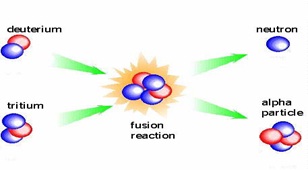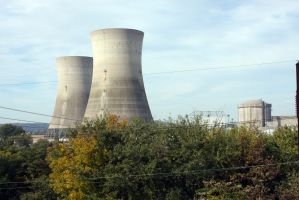Title: A Study Paper on Nuclear Energy
Authors: Yamala Prasanthi & Gunuru Harika sai, 3rd Year BTech, Electrical and Electronics Engineering
College: Dr.L.Bullayya College of Engineering (for women)
ABSTRACT:
Now a days there is a need to generate large amount of Electricity in short period of time to overcome the disadvantage of shortage of electricity, it is the barrier for development. If we take care in some aspects Nuclear Energy is the best way to generate electricity with little amount of Uranium this helps us to overcome the problem of shortage.
INTRODUCTION:
The Energy released during nuclear fission or fusion, especially when used to generate Electricity is known as Nuclear Energy Nuclear power requires uranium, a radioactive metallic element that must be mined from the earth and is not quickly replenished. Nuclear energy does not create air pollution though combustion like fossil fuels.
NUCLEAR REACTIONS:
NUCLEAR FUSION: Fusion occurs when light atomic nuclei are forced close enough together that they combine to form heavier nuclei, releasing energy in the process. This process powers the sun and stars.

NUCLEAR FISSION: Nuclear fission is a nuclear reaction in which the nucleus of an atom splits into smaller parts (lighter nuclei), often producing free neutrons and photons (in the form of gamma rays), and releasing a tremendous amount of energy.
GENERATING ELECTRICITY USING NUCLEAR ENERGY:

A nuclear power station turns the nuclear energy in uranium atoms into electrical energy.
When a neutron – a neutrally charged subatomic particle – hits a uranium atom, the atom sometimes splits, releasing two or three more neutrons. This process converts the nuclear energy that binds the atom together into heat energy.
The fuel assemblies are arranged in such a way that when atoms in the fuel split, the neutrons they release are likely to hit other atoms and make them split as well. This chain reaction produces large quantities of heat.
Water flows through the reactor vessel, where the chain reaction heats it to around 300°C. The water needs to stay in liquid form for the power station to work.
The reactor coolant pump circulates the hot pressurized water from the reactor vessel to the steam generator. Here, the water flows through thousands of looped pipes before circulating back to the reactor vessel. A second stream of water flows through the steam generator, around the outside of the pipes. This water is under much less pressure, so the heat from the pipes boils it into steam.
The steam then passes through a series of turbines, causing them to spin, converting the heat energy produced in the reactor into mechanical energy. A shaft connects the turbines to a generator, so when the turbines spin, so does the generator. The generator uses an electromagnetic field to convert this mechanical energy into electrical energy.
ADVANTAGES OF NUCLEAR ENERGY:
a. Nuclear reactions release a million times more energy, as compared to hydro or wind energy. a large amount of electricity can be generated. Presently, 12-18% of the world’s electricity is generated through nuclear energy.
b. The biggest advantage of nuclear energy is that there is no release of greenhouse gases (carbon dioxide, methane, ozone, and chlorofluorocarbon) during nuclear reaction. The greenhouse gases are a major threat in the current scenario, as they cause global warming and climate change. As there is no emission of these gases during nuclear reaction, there is very little effect on the environment.
c. The burning of fossil fuels result in emission of the poisonous carbon dioxide. It is a menace to the environment as well as human life. There is no release of carbon di-oxide at the time of nuclear reaction.
d. Nuclear reactors make use of uranium as fuel. Fission reaction of a small amount of uranium generates large amount of energy. Currently, the high reserves of uranium found on Earth, are expected to last for another 100 years.
e. High amount of energy can be generated from a single nuclear power plant. Also, nuclear fuel is inexpensive and easier to transport.
DISADVANTAGES OF NUCLEAR ENERGY:
a. Nuclear energy can be used for production and proliferation of nuclear weapons. Nuclear weapons make use of fission, fusion or combination of both reactions for destructive purposes. They are a major threat to the world as they can cause a large-scale devastation.
b. Though large amount of energy can be produced from a nuclear power plant, it requires large capital cost. Around 15-20 years are required to develop a single plant. Hence, it is not very feasible to build a nuclear power plant. The nuclear reactors will work only as long as uranium is available. Its extinction can again result in a grave problem.
c. The waste produced after fission reactions contains unstable elements and is highly radioactive. It is very dangerous to the environment as well as human health, and remains so, for thousands of years. It needs professional handling and should be kept isolated from the living environment. Hence, they have to be carefully stored. It is very difficult to store radioactive elements for a long period
d. The Chernobyl disaster that occurred at the Chernobyl Nuclear Power Plant in 1986 in Ukraine was the worst nuclear power plant disaster. One of the nuclear reactors of the plant exploded, releasing high amount of radiation in the environment. It resulted in thousands of casualties, mostly due to exposure to harmful radiation. One cannot deny the possibility of repetition of such disasters in future.
NUCLEAR ENERGY APPLICATIONS:
- Used in the treatment of cancer by destroying cancerous cells in the patient’s body. Though there are some side effects of radiation therapy.
- If nuclear energy is exposed to food in small amounts, then it is possible to kill harmful germs, micro-organisms and bacteria present in it which cause decaying and disease.
- In manufacturing radio isotopes helps in detecting faults in goods produced. Used to monitor the corrosion of useful industrial equipment.
CONCLUSION:
Nuclear energy is the cheapest way to produce electricity on large scale with one gram of uranium. It is pollution free there is no scarcity of uranium. Once it is successful our country need not worry for power about 10 years. There is chance of explosion these may cause dangerous effects for several years but if take care in constructing nuclear reactor, using hard water for cooling and we want such technology such that we can control the chain reaction after some extent we can make a best use of nuclear energy for electricity generation.
REFERENCES:
- http://en.wikipedia.org/wiki/Nuclear_power
- M. G. Arora and M. Singh (1994). Nuclear Chemistry. Anmol Publications.
- http://www.worldenergy.org/documents/p001515.pdf

